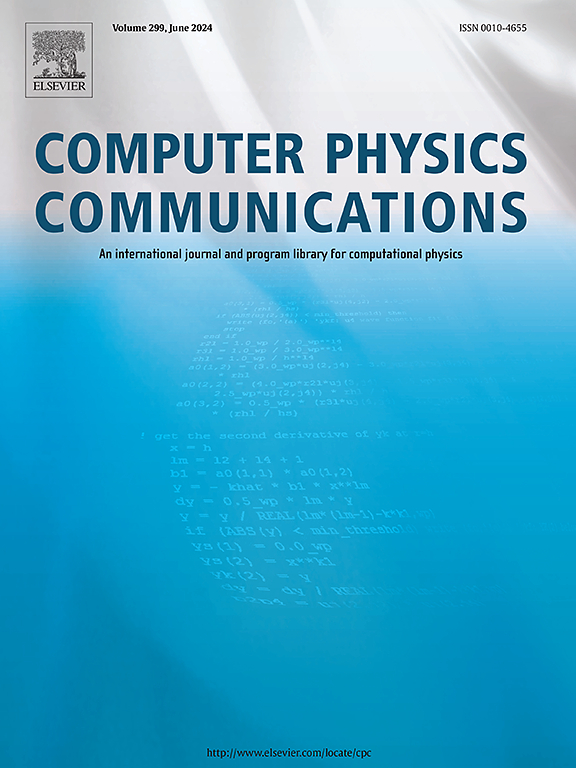An efficiency and memory-saving programming paradigm for the unified gas-kinetic scheme
IF 3.4
2区 物理与天体物理
Q1 COMPUTER SCIENCE, INTERDISCIPLINARY APPLICATIONS
引用次数: 0
Abstract
In recent years, non-equilibrium flows have gained significant attention in aerospace engineering and micro-electro-mechanical systems. The unified gas-kinetic scheme (UGKS) follows the methodology of direct modeling to couple particle collisions and free transport during gas evolution. However, like other discrete-velocity-based methods, the UGKS faces challenges related to high memory requirements and computational costs, such as the possible consumption of 1.32 TB of memory when using 512 cores for the simulations of the hypersonic flow around an X38-like space vehicle. This paper introduces a new UGKS programming paradigm for unstructured grids, focusing on reducing memory usage and improving parallel efficiency. By optimizing the computational sequence, the current method enables each cell in physical space to store only the distribution function for the discretized velocity space, eliminating the need to retain the entire velocity space for slopes and residuals. Additionally, the parallel communication is enhanced through the use of non-blocking MPI. Numerical experiments demonstrate that the new strategy in the programming effectively simulates non-equilibrium problems while achieving high computational efficiency and low memory consumption. For the hypersonic flow around an X38-like space vehicle, the simulation, which utilizes physical mesh cells and discrete velocity space mesh cells, requires only 99.30 GB for 32 cores and 168.12 GB for 512 cores of memory when executed on 512 CPU cores. This indicates that memory consumption in the UGKS is much reduced. This new programming paradigm can serve as a reference for discrete velocity methods for solving kinetic equations.
统一气体动力学格式的一种高效且节省内存的编程范式
近年来,非平衡流在航空航天工程和微机电系统中受到了广泛的关注。统一气体动力学格式(UGKS)采用直接建模的方法,将气体演化过程中的粒子碰撞和自由输运耦合起来。然而,与其他基于离散速度的方法一样,UGKS面临着与高内存要求和计算成本相关的挑战,例如,当使用512核模拟类似x38的太空飞行器周围的高超音速流动时,可能消耗1.32 TB的内存。本文介绍了一种新的用于非结构化网格的UGKS编程范式,重点是减少内存使用和提高并行效率。通过优化计算序列,目前的方法使物理空间中的每个单元仅存储离散速度空间的分布函数,而无需保留整个速度空间的斜率和残差。此外,通过使用非阻塞MPI增强了并行通信。数值实验表明,该规划策略能有效地模拟非平衡问题,同时具有较高的计算效率和较低的内存消耗。对于类似x38的航天飞行器周围的高超音速流,模拟利用1,058,685个物理网格单元和4,548个离散速度空间网格单元,在512个CPU内核上执行时,32核仅需要99.30 GB的内存,512核仅需要168.12 GB的内存。这表明UGKS中的内存消耗大大减少了。这种新的编程范式可作为求解动力学方程的离散速度方法的参考。
本文章由计算机程序翻译,如有差异,请以英文原文为准。
求助全文
约1分钟内获得全文
求助全文
来源期刊

Computer Physics Communications
物理-计算机:跨学科应用
CiteScore
12.10
自引率
3.20%
发文量
287
审稿时长
5.3 months
期刊介绍:
The focus of CPC is on contemporary computational methods and techniques and their implementation, the effectiveness of which will normally be evidenced by the author(s) within the context of a substantive problem in physics. Within this setting CPC publishes two types of paper.
Computer Programs in Physics (CPiP)
These papers describe significant computer programs to be archived in the CPC Program Library which is held in the Mendeley Data repository. The submitted software must be covered by an approved open source licence. Papers and associated computer programs that address a problem of contemporary interest in physics that cannot be solved by current software are particularly encouraged.
Computational Physics Papers (CP)
These are research papers in, but are not limited to, the following themes across computational physics and related disciplines.
mathematical and numerical methods and algorithms;
computational models including those associated with the design, control and analysis of experiments; and
algebraic computation.
Each will normally include software implementation and performance details. The software implementation should, ideally, be available via GitHub, Zenodo or an institutional repository.In addition, research papers on the impact of advanced computer architecture and special purpose computers on computing in the physical sciences and software topics related to, and of importance in, the physical sciences may be considered.
 求助内容:
求助内容: 应助结果提醒方式:
应助结果提醒方式:


